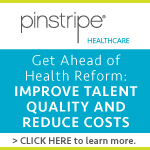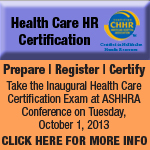ASHHRA eNews Pulse
ASHHRA
ASHHRA eNews Brief: July 2013
ASHHRA NEWS
The eligibility requirements are now available for the Certified in Healthcare Human Resources (CHHR) exam. If you qualify to take the exam, the application is also ready for you.
Visit http://www.ashhra.org/learning/certification.shtml to view the full article online.

WORKFORCE
By Derek Thompson Since 2003, the U.S. health care sector has grown more than 10-times faster than the rest of the economy. Here's what that graph (via Brookings) says. In the last 10 years, job growth in America's non-health-care economy has been dreadful. Just 2.1 percent total—or barely 0.2 percent per year. (Yes, that's point-two percent annual growth.) In that time, the U.S. health care sector has grown more than 10-times faster than the rest of the economy, adding 2.6 million jobs. SOURCE: THEATLANTIC.COM
Visit http://www.theatlantic.com/business/archive/2013/07/a-truly-astonishing-graph-of-the-growth-of-health-care-jobs-in-america/277454/ to view the full article online.
By Sue Ter Maat When Oklahoma City ob-gyn Jonathan Egly, MD, was in residency about two years ago, he got two job solicitations a week. During a job search more recently, he received more than four times that amount—eight to 10 notices weekly by email, direct mail and phone calls. Dr. Egly didn't like all the job feelers bombarding him, although he did like one enough to pursue it. "I take these with a grain of salt, but as it turns out, I landed a job," said Dr. Egly, who starts his new position in two months in San Antonio. SOURCE: AMEDNEWS.COM
Visit http://amednews.com/article/20130708/business/130709921/1/ to view the full article online.
By Sharon Johnson The Affordable Care Act, which is expected to boost hospital admissions, has intensified a decades-old battle over the number of nurses who should be available to patients at all times. Championed by National Nurses United, a 185,000-member national nurses union based in Silver Spring, Md., bills vehemently opposed by hospital administrators are working their way through seven state legislatures—Florida, Iowa, Michigan, Minnesota, New Jersey, New York, and Texas—the District of Columbia city council and the U.S. Senate. SOURCE: WOMENSENEWS.ORG
Visit http://womensenews.org/story/labor/130707/how-many-nurses-aca-intensifies-hospital-debate to view the full article online.

COMPENSATION
By Jay Hancock Like hospital leaders everywhere, the people running Valley Medical Center in Renton, Wash., talk frequently about the need to control soaring medical costs. "We are working to reduce the overall cost of health care and to transform health care delivery," Lisa Jensen, chairwoman of the hospital's board of trustees, said last year. Experts believe that's a good prescription for the entire U.S. health industry, which costs the economy far more than systems in other developed countries, delivers mediocre results, and is widely seen as unsustainable at its current growth rate. SOURCE: HEALTHCARE FINANCE NEWS
Visit http://www.healthcarefinancenews.com/news/hospital-ceo-bonuses-reward-volume to view the full article online.
By Madelyn Kearns The latest installment of the swooping MGMA Physician Compensation and Production Survey: 2013 Report Based on 2012 Data dubs quality and patient satisfaction as measures expected to have a considerable impact on compensation structures in the coming years. SOURCE: HEALTHCARE FINANCE NEWS
Visit http://www.healthcarefinancenews.com/news/doctor-pay-may-depend-patients to view the full article online.
GENERAL HR
By Debra Beaulieu An employee's first 90 days are a crucial period for building a long and successful working relationship with your practice. And with the threat of costly turnover higher than ever—with 34 percent of health care workers looking for new jobs, according to research from CareerBuilder—you can't afford not to invest in getting your new hires off to a strong start. SOURCE: FIERCE PRACTICE MANAGEMENT
Visit http://www.fiercepracticemanagement.com/story/3-tips-successful-employee-onboarding/2013-07-03 to view the full article online.
By Kevin Fuller When hospitals look at their bottom lines, staff is typically one of the casualties. However, experts say being understaffed can ultimately cost a hospital. "It’s more expensive to under staff," said Cheryl Wagner, associate dean of graduate nursing programs at American Sentinel University. Wagner has been researching and writing about the issue of under staffing for years and said hospitals need to start utilizing evidence-based staffing as opposed to arbitrarily deciding how many staff it needs. SOURCE: HEALTHCARE FINANCE NEWS
Visit http://www.healthcarefinancenews.com/news/3-reasons-use-evidence-based-staffing to view the full article online.
By Rodney J. Moore A recent study of more than 400 employees in professional and administrative occupations found that there is an optimum level of workaholism for achieving job effectiveness and positive health but extremes are dangerous. "We discovered that workaholics really struggle when they feel that they are alone or swimming upstream without a paddle," said Wayne Hochwarter, a professor of business administration at Florida State University and co-author of the study. SOURCE: HEALTHCARE FINANCE NEWS
Visit http://www.healthcarefinancenews.com/news/workaholism-rise-health-care to view the full article online.

PHYSICIANS
By Karen Caffarini If a doctor in your practice leaves, does your practice have a plan for what to do? Practice experts say you need a contingency plan to ensure a seamless transition should a doctor retire or leave unexpectedly and with little notice. Without a plan, practices run the risk of overtaxing their remaining physicians, disrupting patient flow, losing profits, and possibly watching patients go elsewhere. SOURCE: AMEDNEWS.COM
Visit http://amednews.com/article/20130708/business/130709933/5/ to view the full article online.
The U.S. faces an uneven distribution of primary care physicians in poor and rural areas compared with other parts of the country, according to a June analysis by the Robert Graham Center for Policy Studies in Family Medicine and Primary Care. SOURCE: AMEDNEWS.COM
Visit http://amednews.com/article/20130701/business/130709995/9/ to view the full article online.
HOSPITAL NEWS
By Sandra G. Boodman Flavio Casoy vividly remembers one of his scariest moments as an intern: On duty at a San Francisco hospital for nearly 29 hours, he was at the bedside of a very sick patient when the man's oxygen level began to plummet. Casoy stared, transfixed, at the monitor. "I knew something was wrong, but I couldn't make myself think," he recalled. Only after "a colleague walked into the room, pushed me on the shoulder and said, 'Get going' " did the exhausted doctor spring into action. SOURCE: KAISER HEALTH NEWS
Visit http://www.kaiserhealthnews.org/Stories/2013/July/09/intern-work-hours.aspx to view the full article online.
MANAGEMENT & LEADERSHIP
By Amy J.C. Cuddy, Matthew Kohut, and John Neffinger Is it better to be loved or feared? Niccolò Machiavelli pondered that timeless conundrum 500 years ago and hedged his bets. "It may be answered that one should wish to be both," he acknowledged, "but because it is difficult to unite them in one person, it is much safer to be feared than loved." SOURCE: HARVARD BUSINESS REVIEW MAGAZINE
Visit http://hbr.org/2013/07/connect-then-lead/ar/1 to view the full article online.
|
|











